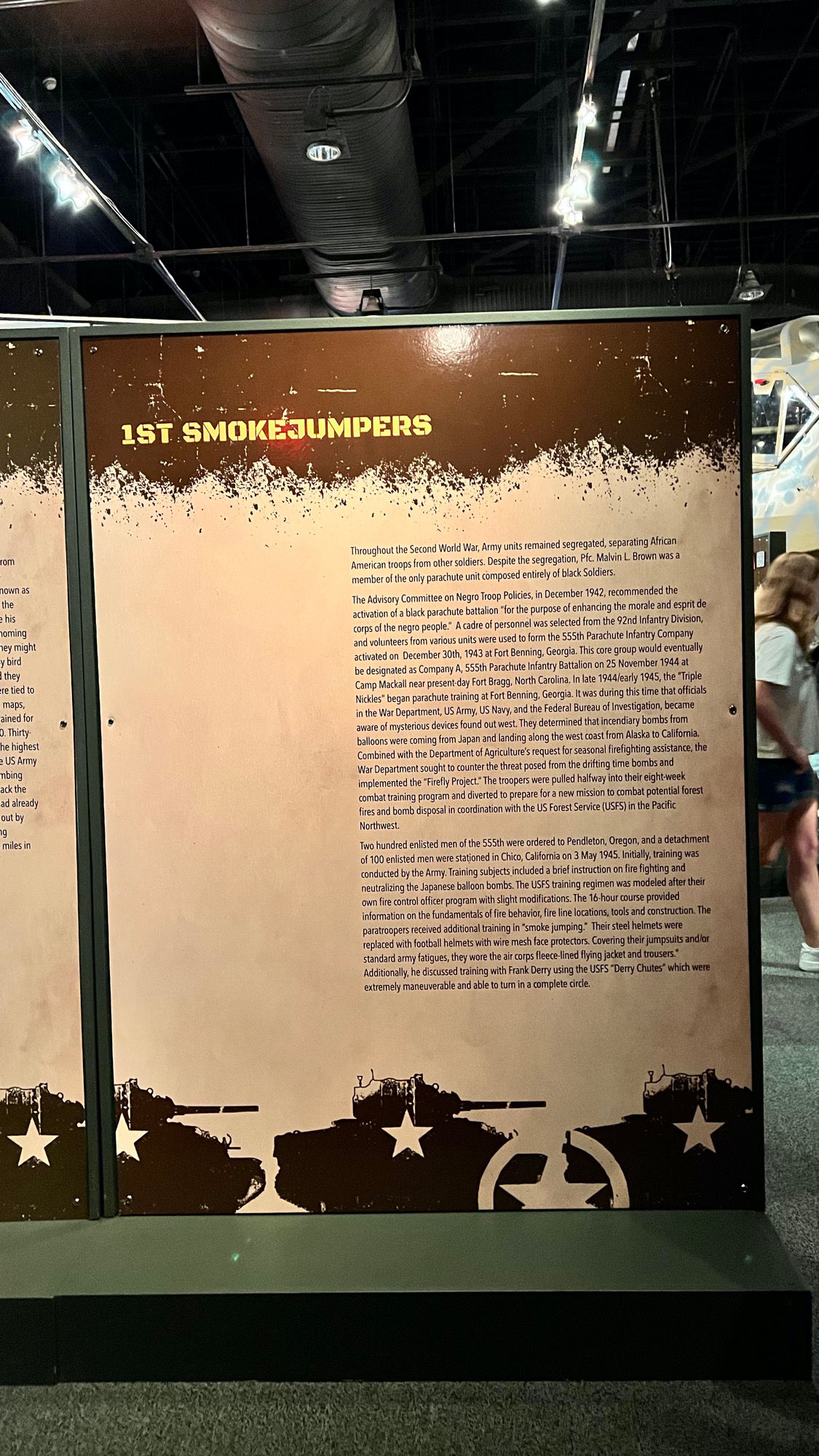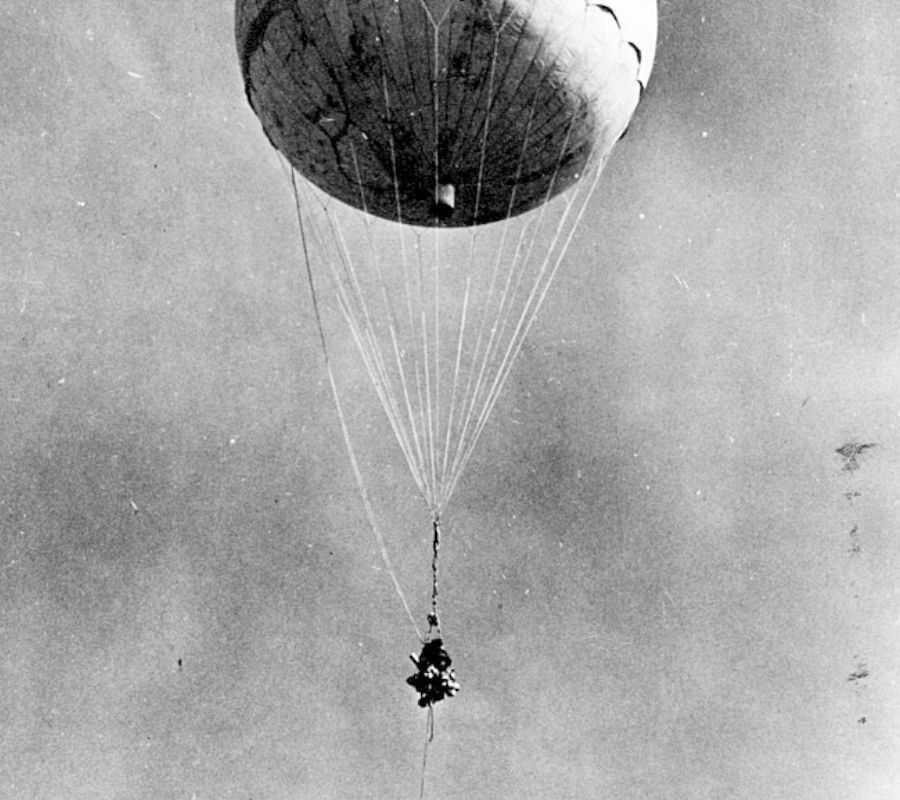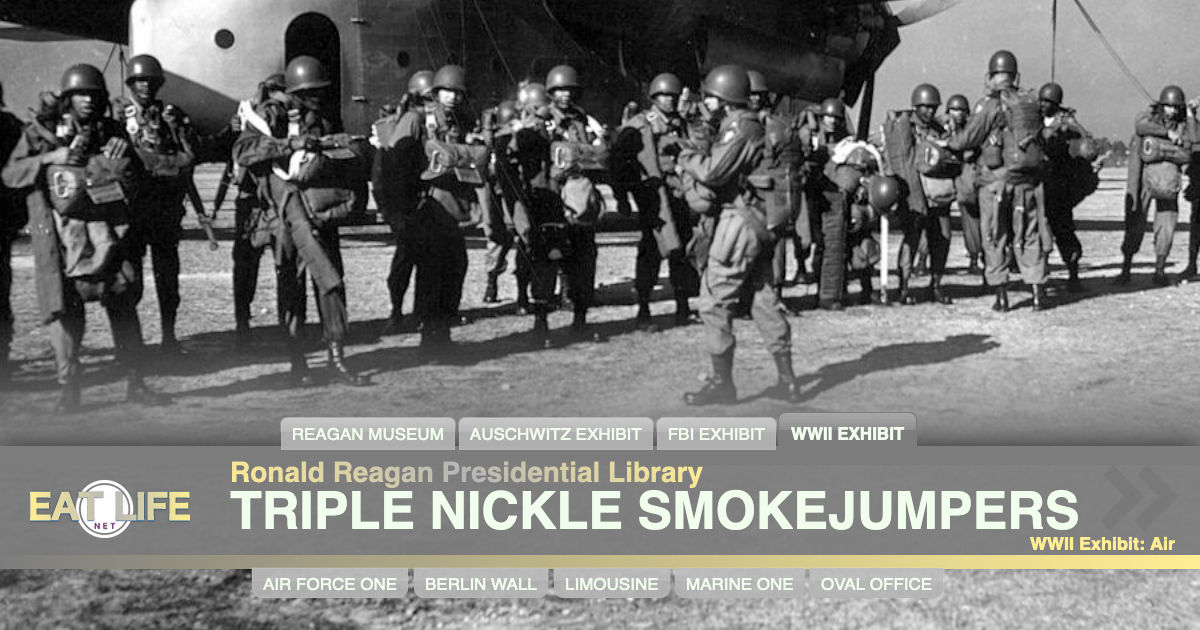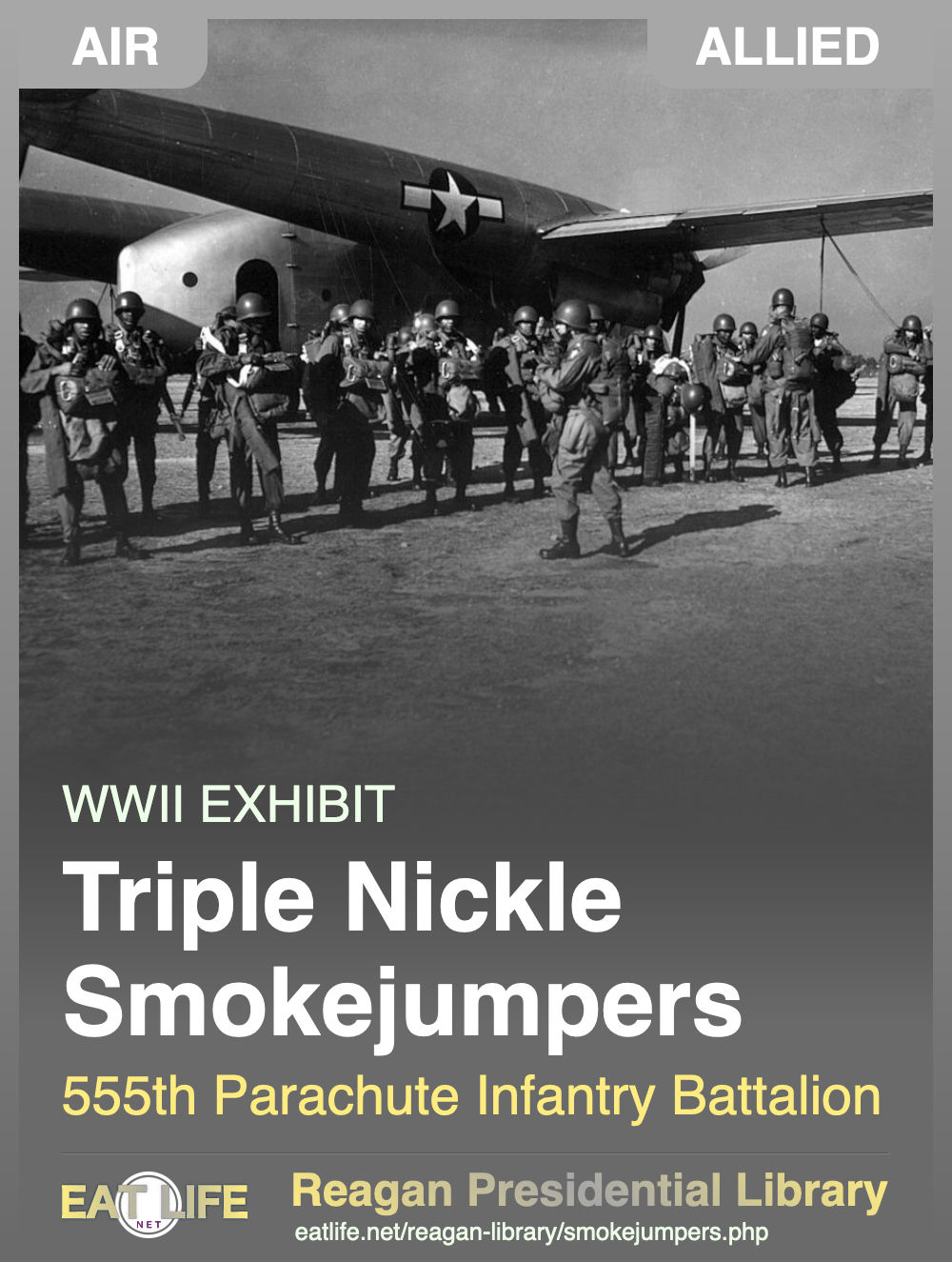The Triple Nickles became the nation's first Black parachute infantry test platoon, company, and battalion. The unit was secretly assigned to a series of firefighting missions in the Pacific Northwest Region. This special assignment, called Operation Firefly was to battle wildfires that were set ablaze by incendiary bombs from balloons were coming from Japan and landing along the west coast from Alaska to California. The 555th worked on twenty-eight fires during the 1945 season.

555th Parachute Infantry Company
Throughout the Second World War, Army units remained segregated, separating African American troops from other soldiers. Despite the segregation, PFC Malvin L. Brown was a member of the only parachute unit composed entirely of black Soldiers.
The Advisory Committee on Negro Troop Policies, in December 1942, recommended the activation of a black parachute battalion "for the purpose of enhancing the morale and esprit de corps of the negro people." A cadre of personnel was selected from the 92nd Infantry Division, and volunteers from various units were used to form the 555th Parachute Infantry Company activated on December 30th, 1943 at Fort Benning, Georgia. This core group would eventually be designated as Company A, 555th Parachute Infantry Battalion on 25 November 1944 at Camp Mackall near present-day Fort Bragg, North Carolina.
In late 1944 / early 1945, the "Triple Nickles" began parachute training at Fort Benning, Georgia. It was during this time that officials in the War Department, US Army, US Navy, and the Federal Bureau of Investigation, became aware of mysterious devices found out west. They determined that incendiary bombs from balloons were coming from Japan and landing along the west coast from Alaska to California. [eatlife.net/wwii/fu-go.php] Combined with the Department of Agriculture's request for seasonal firefighting assistance, the War Department sought to counter the threat posed from the drifting time bombs and implemented the "Firefly Project." The troopers were pulled halfway into their eight-week combat training program and diverted to prepare for a new mission to combat potential forest fires and bomb disposal in coordination with the US Forest Service (USFS) in the Pacific Northwest.
Two hundred enlisted men of the 555th were ordered to Pendleton, Oregon, and a detachment of 100 enlisted men were stationed in Chico, California on 3 May 1945. Initially, training was conducted by the Army. Training subjects included a brief instruction on fire fighting and neutralizing the Japanese balloon bombs. The USFS training regimen was modeled after their own fire control officer program with slight modifications. The 16-hour course provided information on the fundamentals of fire behavior, fire line locations, tools and construction. The paratroopers received additional training in "smoke jumping." Their steel helmets were replaced with football helmets with wire mesh face protectors. Covering their jumpsuits and/or standard army fatigues, they wore the air corps fleece-lined flying jacket and trousers." Additionally, training with Frank Derry using the USFS "Derry Chutes" which were extremely maneuverable and able to turn in a complete circle.
USDAIt has been said that Black history is simply the missing pages of world history. Nothing could be truer. The Triple Nickles African American paratrooper unit left their mark, not only in Black history but, ultimately, in the history of the Army, the Forest Service and our great country.The 555th Parachute Infantry Battalion was a pioneering paratrooper unit of the United States Army. Instated in 1943 during World War II, the unit was given the unprecedented and undeniably dangerous job of jumping into forests that were set on fire by the nation's enemy at war. The unit was nicknamed the Triple Nickles because of its numerical designation and because 17 of the original 20-member "colored test platoon" came from the 92nd Infantry Division, or Buffalo Division. Hence, the nickname Buffalo Nickles, symbolized by three buffalo nickels joined in a triangle. The unit's 75-year legacy intersects with USDA Forest Service history in a very special way.
At a time when the Army traditionally relegated Black service members to menial jobs, the Triple Nickles succeeded in becoming the nation's first Black parachute infantry test platoon, company and battalion.
The Triple Nickles was a skilled mix of former university students, top-notch professional athletes and veteran non-commissioned officers. Unlike other divisions of the army, the Triple Nickles did not deploy overseas during World War II. Instead, in 1945, the unit was secretly assigned to a series of firefighting missions in the Pacific Northwest Region. This special assignment, called Operation Firefly, saw the Triple Nickles transferred to Pendleton, Oregon. While there, the unit was trained by the Forest Service to become the first military smokejumpers in U.S. history.
That spring, the Triple Nickles parachuted into U.S. forests to battle wildfires that were set ablaze by incendiary balloons the Japanese were delivering across the Pacific Ocean. The Triple Nickles went on to operate in all the northwestern states. When the battalion was finally deactivated in 1947, their impact was undeniable.
WIKIPEDIAThe Triple Nickles
The 555th Parachute Infantry Battalion was nicknamed the "Triple Nickles" because of its numerical designation and the selection of 17 of the original 20-member "colored test platoon" from the 92nd Infantry (Buffalo) Division. Hence, the origin of the nickname, Buffalo Nickles. Not to be confused with the U.S. 5-cent coin that had a bison (buffalo) on it, which was first minted long before the war, the spelling derives from old English. Three buffalo nickels joined in a triangle or pyramid is the identifying symbol.The battalion did not serve overseas during World War II, primarily because it never reached full strength for an Airborne Infantry Battalion. In reaction to the German counterattack that began the Battle of Bulge, the Airborne Command considered reorganizing the 555th PIB as a single reinforced Airborne Rifle Company, and sending it to Europe to reinforce the battered Airborne units already there. However, before this could happen the crisis had passed, and the 555th PIB was instead alerted for deployment to the West Coast. The men of the 555th PIB hoped that they would get into the war against the Japanese, but that was not their new mission. According to Sergeant Walter Morris, "It was a secret mission called Operation Firefly. We thought we were going overseas to MacArthur's theater." It wasn't until they arrived in Oregon, in May 1945, that they learned they would be fighting the Japanese on the fire line in the Western United States.
During the winter of 1944–45, the Japanese sent 9,300 Fu-Go balloon bombs toward North America. It was believed 1,000 succeeded in reaching the United States; 312 balloon bombs have been found. After three days, each balloon dropped an incendiary bomb. The balloon bombs employed a ballast system designed to maintain an average altitude of 30,000 feet. Incendiary bombs would be dropped one at a time (four 11-pounders) and a single high-explosive bomb (33 pounds) would be dropped followed by a self-destruct device. In order to conceal the efficacy of these attacks, the missions of the 555th PIB was kept clandestine in nature. By January 1945, however, both Time and Newsweek reported the mission.
Although there were no significant wildfires, small ones nonetheless developed from some of the balloon bombs being detonated suddenly after landing on the forests undisturbed for weeks or months mainly in California, Oregon, or Idaho. Stationed at Pendleton Field, Oregon (formerly the base of the pilots and aircraft selected for the Doolittle raid on Japan), with a detachment in Chico, California, unit members participated in fire-fighting missions throughout the Pacific Northwest during the summer and fall of 1945. The 555th worked on twenty-eight fires during the 1945 season. Of these, fifteen fires were "jumped" or parachuted to. While some United States Forest Service reports refer to some employees as smokejumpers, the 555th were reported as paratroopers on all fire reports. The only fatality in the unit died while jumping on 6 August 1945.
Soon afterward, individual black paratroopers were transferred to units throughout the 82d Airborne Division, making it the first integrated division in the US Army. The 555th PIB was formally disbanded 22 August 1950.









